JUNE 2003 SOLSTICE EXPEDITION:
Archaeoastronomical Mysteries in South America
WITH WILLIAM SULLIVAN
The ancient Hindus called the Milky Way ‘The Bed of the Ganges’, and the Egyptian Pharaohs sailed in golden barques down the Nile, in anticipation of the after-life journey across the Milky Way. The Andean peoples participated in the ancient geomantic tradition of rendering terrestrial space sacred by conceiving it as a template of the sky.
Beginning with a visit to Lake Titicaca, the spiritual center of Andean civilization, on to Cuzco the capital of the Inca Empire and through the Sacred Valley from Pisaq to the fabled site of Macchu Picchu and the stunning June solstice sunrise over the Pyramid of Ollantaytambo, we will travel a trajectory through time and sacred space that is the equivalent of a symbolic sojourn along the Milky Way.
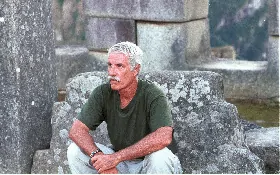
Dr. William Sullivan, author of Secret of the Incas: Myth Astronomy, and the War Against Time, has agreed to guide a DuVersity tour in Peru. He featured in a Channel 4 documentary seen in the UK and Europe. Bill has researched the astronomical knowledge of early South America and made new discoveries. He was greatly influenced by the book Hamlet’s Mill written by de Santillana and von Dechend in the 1960s, which claimed that all early cultures across the planet shared in an understanding of cosmic cycles linked to human history. Such knowledge may date back 10,000 years and came to include astronomical knowledge, particularly as regards the precession of the equinoxes, a cycle of almost 26,000 years, whose discovery brought about a revolution in human thinking, since it revealed that even the heavens were not unchanging. Bill was able to show that the same tradition of knowledge was known in South America.
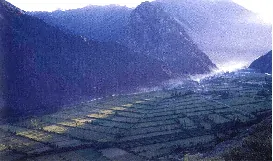
Amongst the sites to be explored is the so-called Sacred Valley of the Incas that seems to have been worked to depict astronomical objects and knowledge on a very large scale. Among these objects is a pyramid of a form previously unknown. A sixty kilometer stretch of the Urubamba was in effect sculpted to resemble the celestial river in the sky, the Milky Way. As in recent archaeological research in Africa, it is beginning to be realized that there may well be massive remains of ancient knowledge that have simply not been noticed until now.

“By day, in the thin, dazzling air of highland Peru and Bolivia, there vibrates a song of inconsolable sadness. From the shame of crumbling, gully-washed terraces on endless, abandoned hillsides, to the desolation of square miles of alkali-encrusted altiplano around Lake Titicaca, the injured earth cries out for her lost husbandmen. She is Pachamama, ‘our mother in space-time’. Four and a half of her six million children lay dead within fifty years of the Conquest. The survivors, the salt of the earth, who have endured through the centuries the degradation, disdain and suffering of the cataclysm, have never forgotten her.
“By night, as black dogs huddle together for warmth, and the visible scars of profane history lie blanketed in oblivion, a firmament of unblemished brilliance blazes forth in fierce affirmation of once and future worlds. Here, on the vault of heaven, are written the sacred thought-forms of Andean civilization. Here the Milky Way, in other climes a brightish band in the night sky, scintillates with such intensity that its great whorls of interstellar dust appear in stunning definition, inky black and fathomless. These black clouds are named: llama, condor, partridge, toad, serpent, fox. Myth is told at night.” (From The Secret of the Incas by William Sullivan)
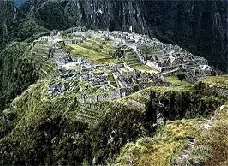
“When we consider the Andean societies we see that myths constituted part of their sacred history. That history explained in a coherent fashion an idealized conception of their sacred origins as well as subsequent human acts and was meant to legitimize, in the eyes of other societies, the truth of their divine origin and consequently, the superiority of their model of social, political and religious organization. Images were born of an overwhelming need to search for the light through astronomical alignment, or through a system which allowed man to explain that he is a being connected to a cosmic vitality.” (Foreword to The Sacred Valley of the Incas by Fernando and Edgar Elorrieta Salazar)
PROPOSED ITINERARY:
June 14-23 , 2003
Saturday, 14th US / Bolivia
Afternoon Departure on American Airlines for Miami with evening connection to La Paz, Bolivia.
Sunday, 15th La Paz

Arrive La Paz early morning and check in at Plaza Hotel. Day free to rest and adjust to altitude; optional afternoon city tour.

Perched on the edge of the altiplano, Bolivia’s capital overlooks a barren plateau at an altitude of 3, 579 m or 11,811 feet above sea level. Set in a lunar-like landscape of great beauty, La Paz is nestled in a bowl-shaped valley. Even the locals walk slowly here.
At sunset, Mount Illimani, a 6,363 m or 21,000 feet high glacier, is painted in golden red colors, a breathtaking sight in the world’s highest capital.

Monday, 16th: La Paz / Lake Titicaca/ Tihuanaco / Copacabana
We leave after breakfast on a comfortable touring bus for Tihuanaco,
said to be the cradle of Andean civilization. On this important
archeological site, 5 different cities were built over time, one on
top of the other. The Puerta del Sol, or Gate of the Sun, is an
imposing stone fixture believed to be a solar calendar built by a
civilization around 600 BC which disappeared around AD 1200.
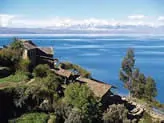
Tuesday, 17th Copacabana/Islands of the Sun and Moon / Puno
Early in the morning and warmly dressed, we board a simple, two-motor launch for our trip to the islands. According to Inca mythology, the earth trembled underneath the waters of the lake when life began. The Children of the Sun rose from the waters of their mother, the earth; and the sun and the earth would go on making life.
We visit the Women’s Temple on the Island of the Moon and return to our boat for the next stop at the Island of the Sun.
The Island of the Sun is the legendary birthplace of Manco Capaq and Mama Oqlla, the first Inca and his queen. In the Temple of the Sun, high over the lake and under the watchful eyes of Apu Illimani, we have time for quiet reflection, gathering of stones and picture-taking.
After a picnic lunch on board, we return to Copacabana , board our bus and continue on to Puno, crossing into Peru. Check-in at Hotel La Posada del Inca and Group Dinner.

Wednesday, 18th Puno / Raqchi / Cuzco
This long day begins with an early departure for Raqchi, with our bus traveling at a fast clip along a modern two-way road, over high mountain passes and through valleys with grazing llamas and alpacas.
In Raqchi, we visit the famous Wiraqocha Temple and have a leisurely picnic lunch on the shore of the Willkanusta River. In the early afternoon we continue on to Cuzco, with arrival in the ancient capital of the Incas in the early evening. Check-in at the Hotel Libertador with the rest of the evening free;

Thursday, 19th Cuzco
We spend a relaxed day walking and driving through the city, steeped
in history, tradition and legend. Surrounded by the breathtakingly
beautiful Andean mountains, Cuzco is a mysterious blend of temples,
churches, markets, elegant stores and restaurants offering exotic international foods.
During an optional City Tour, we visit the Cathedral; walk through Saqsayhuaman, the stone temple above the city, the Qoricancha, the Sun Temple of the Incas, and other beautiful and ancient sites.
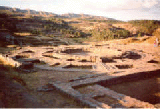
After a group lunch in one of Cuzco’s favorite eateries, the afternoon is free for rest and shopping.

Friday, 20th Cuzco/Sacred Valley
We leave after breakfast for a short bus ride to Pisaq, traveling past snow-covered mountains and along the ancient Willkanusta River. The ruins of Pisaq are on a hilltop above the small town. Above the spectacular agricultural terracing which sweeps around the South and East in graceful curves are cliff-hanging footpaths, well defended by massive stone doorways, steep stairs and a tunnel carved out of the rock. We walk through the ancient ruins which feature rooms, temples, tombs and baths.
After lunch in one of the Sacred Valley’s well-known open-air restaurants, we continue on to Ollantaytambo at the other end of the valley and check into the modest Hotel Pacaritambo.
Ollantaytambo is a major Inca site, dominated by a massive temple with views of the mountains, valley and the Willkanusta River. We spend the evening listening to Dr. Sullivan’s talk about the city and his important work there.

Saturday, 21st Ollantaytambo/ Solstice
Very early in the morning, we walk up to the Pyramid above the city to see the Solstice Sun rising in the East.
The rest of the day is free and may include an optional walk around Ollantaytambo with Dr. Sullivan.
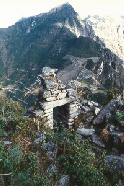
Sunday, 22nd Ollantaytambo / Machu Picchu
The inveterate early risers will hike up to the Eye of the Llama before the group meets for breakfast and we walk to the train station for our 2-hour trip to Aguas Calientes. After checking in at the Pueblo Hotel, we meet for lunch in the village and catch the last bus of the day to Machu Picchu, the best-known and most spectacular archeological site on the continent.
After a guided tour through the ancient city, the afternoon and evening are free.

Monday, 23rd Machu Picchu
Dr. Sullivan will accompany the group to the Pachamama Cave, also known as the Temple of the Moon, in the belly of Huayna Picchu; a hike all the way to the top of Huayna Picchu, the younger Picchu, will also be possible in the afternoon.
The group meets for dinner in the village, followed by an optional bath at the famous hot springs of Aguas Calientes.
Tuesday, 24th Machu Picchu / Cuzco
After a morning departure by train, we arrive in Cuzco in mid-day and check into the Hotel Libertador. The rest of the day is free for resting, sightseeing and shopping.

Wednesday, 25th Cuzco/Lima/US
After breakfast, we travel by bus to the airport for our short flight from Cuzco to Lima. We check into the La Posada Del Inca Hotel. Those who wish may visit Caral, the site of six recently discovered pyramids dating to 2600 B.C.
The site’s central zone contains six large mounds, many smaller platform mounds, two sunken circular plazas, and various residences and buildings. Platform mounds housed high-status citizens and served ceremonial functions.
Thursday, 26th Miami / Personal Destinations
We depart for Miami Thursday morning and transfer to our personal domestic flights, with arrival in most home cities in the late afternoon.
The cost of the trip is estimated at $ 4,200 including airfare
This price includes:
· Air transportation from Miami to La Paz and Lima to Miami, plus all domestic transport via air, train and land travel in luxury touring buses.
· Most meals – daily breakfast and one meal along with Farwell dinner the last night of the trip
· Accommodations in both world class five star hotels and otherwise excellent hotels-double occupancy
· All entrance fees to sites
· Travel information, reading lists and a copy of “The Secret of the Incas” by William Sullivan
· A year’s membership of the DuVersity for 2003-4
If you wish to book your own airline reservations the cost of the trip as listed above will be $3200.
JUNE 2003 SOLSTICE EXPEDITION – Archaeoastronomical Mysteries in South America is sponsored and organized by the DuVersity. Cultural Immersion Travel will be acting as our facilitator.
More detailed information will be available in the future.
